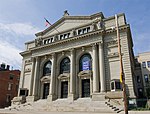Cincinnati Music Hall

Music Hall, commonly known as Cincinnati Music Hall, is a classical music performance hall in Cincinnati, Ohio, completed in 1878. It serves as the home for the Cincinnati Ballet, Cincinnati Symphony Orchestra, Cincinnati Opera, May Festival Chorus, and the Cincinnati Pops Orchestra. In January 1975, it was recognized as a National Historic Landmark by the U.S. Department of the Interior for its distinctive Venetian Gothic architecture. The building was designed with a dual purpose – to house musical activities in its central auditorium and industrial exhibitions in its side wings. It is located at 1241 Elm Street, across from the historic Washington Park in Over-the-Rhine, minutes from the center of the downtown area. Music Hall was built over a pauper's cemetery, which has helped fuel its reputation as one of the most haunted places in America.In June 2014, Music Hall was included on the National Trust for Historic Preservation's annual list of America's 11 most endangered historic places.
Excerpt from the Wikipedia article Cincinnati Music Hall (License: CC BY-SA 3.0, Authors, Images).Cincinnati Music Hall
Central Parkway, Cincinnati Over-the-Rhine
Geographical coordinates (GPS) Address Website External links Nearby Places Show on map
Geographical coordinates (GPS)
| Latitude | Longitude |
|---|---|
| N 39.109444444444 ° | E -84.518888888889 ° |
Address
Music Hall
Central Parkway
45223 Cincinnati, Over-the-Rhine
Ohio, United States
Open on Google Maps








